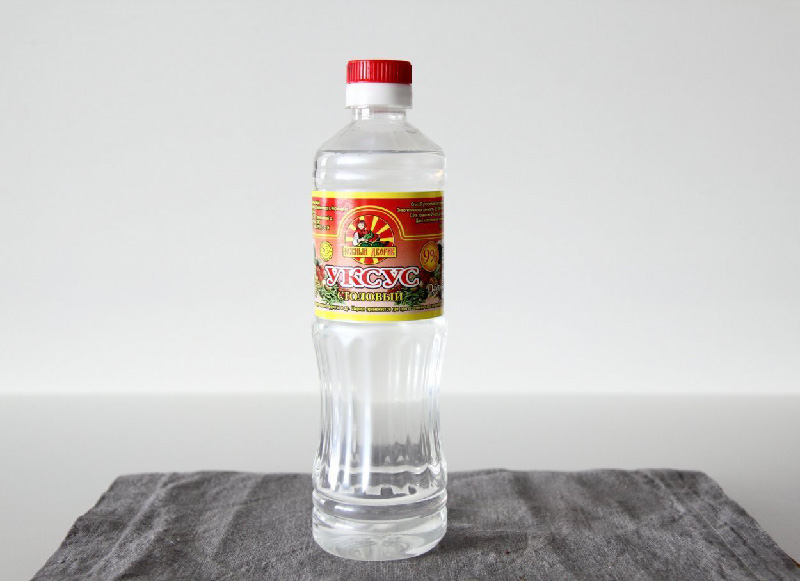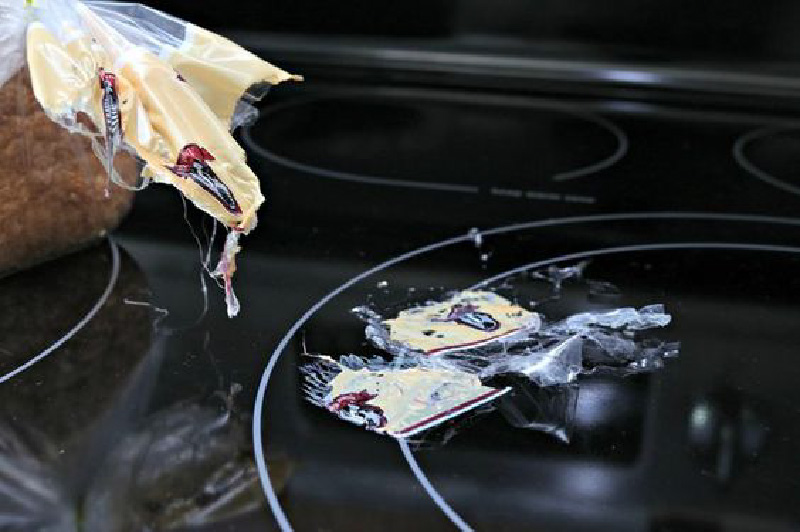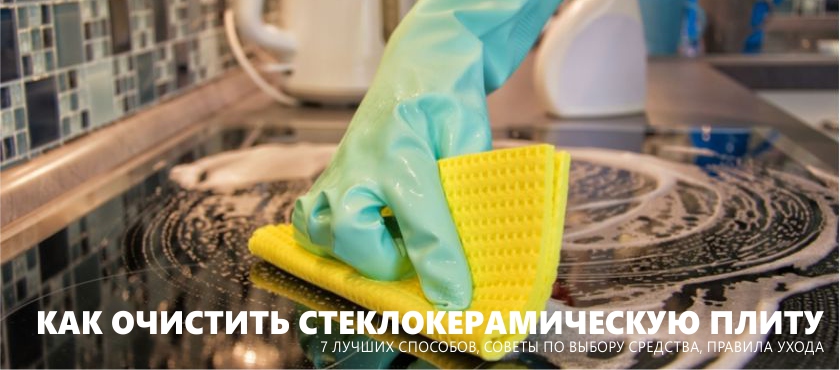All manufacturers recommend cleaning the glass-ceramic stove only with soapy solutions or special products for glass-ceramic (in the form of creams, pastes or sprays). The latter are good in that they not only clean the surface of the plate, but also leave a dirt-repellent film on it, add shine.
But what to do if a special cleaner was not at hand, or it simply can not wash persistent dirt? In this case, you will gain funds from your first-aid kit or kitchen cabinet, as well as our advice on choosing more effective tools for glass-ceramic.
If you have a gas stove, see the material: How to clean the gas stove in 8 steps
Method 1. How to care for a glass ceramic stove every day
This method is the only one that is officially allowed to be used by all manufacturers of glass-ceramic plates for daily cleaning.
Instruction:
- After cooking (or in the process), while the cooker is still hot, carefully remove scorched liquids and food residue with a scraper.

- When the cooker cools down (!), Clean the dirty areas with soapy water (for example, dishwashing liquid) and rub them with a not too hard sponge. You can also wash the stove with a wet sponge and soap.

- Remove stubborn stains with a special paste or cream for glass-ceramic.
- Wipe the plate clean and dry, removing the remnants of the tool itself.
Tips:
- A soap solution or a frothy cap from it can be left on the stove for 20-40 minutes. The main thing is that the liquid does not flow out of the plate.
- The main tool for cleaning the ceramic hob is a glass scraper. How to use it? Position the scraper at a sharp angle to the surface of the plate and simply slide it back and forth.
Method 2. How to clean soda-glass stove
We want to warn you right away: all manufacturers prohibit the use of soda to clean glass ceramics due to its abrasive properties (micro-scratches remain on the surface, because of them some shine is lost). However, as practice shows, soda does not bring significant harm, and most users use it to wash glass-ceramic regularly. If your stove is very dirty and there is nothing at hand, you can try this cleaning method.

Due to its alkaline properties, it copes well with old carbon deposits, dirt and grease.
Instruction:
- Sprinkle soda over the entire surface of the stove.
- In a small bowl, prepare a solution of hot water and dishwashing liquid.
- Moisten the towel well in a soapy solution and cover the plate completely with it as shown in the photo.

- Leave a towel for 15-30 minutes to reduce contamination.
- Scrub the surface of the slab with the same towel, using the soda residue as a lint against carbon deposits and dirt.
- Wash thoroughly and wipe the glass ceramic clean and dry. If desired, use 9% vinegar to quickly remove residual soda.
Tips:
- Instead of one large towel, you can use two small ones.
- The towel should be wet enough to dissolve the soda and wet the surface, but not so wet that puddles form, and water flows out of the stove.
- This method of cleaning can be used immediately after the method number 3 (see below) - so cleaning will be even more efficient.
- Particularly persistent contaminants can be removed with soda paste (soda + water in a 1: 1 ratio). In this video you can see how to clean a glass-ceramic stove with soda paste.
Method 3. How to wash the glass-ceramic stove with 9% vinegar
Vinegar is an excellent tool for cleaning the glass-ceramic plate from lime stains and grease. Yes, it is effective nothing more than dishwashing liquid or a regular spray for cleaning glass ceramics, but it is always on hand and inexpensive.

- When the cooker cools, spray or wet the stains with 9% vinegar, wipe the cooktop with a damp cloth to remove the contaminants.
- Wipe the plate clean and dry.
Method 4. How to clean a glass-ceramic stove with toothpaste
Whitening toothpastes contain fine and delicate abrasive particles that can remove scorch, dirt and grease. Simply apply the paste to the dirty areas, sponge them and rinse thoroughly to remove any remaining toothpaste.
Method 5. Cleaning the plate wiper
The wiper on the basis of ammonia well removes grease and dirt from the glass-ceramic plate, and also restores its luster.
Instruction:
- Spray glass cleaner on the stove and wipe with a cloth or moderately hard sponge.
- Wipe the cooktop with a damp microfiber cloth.
Method 6. Removal of complex stains with a melamine sponge
Melamine sponge can easily and quickly handle glass ceramics, but it should be used carefully. Before using it, we recommend that you familiarize yourself with the contraindications and properties of the product.
Instruction:
- Spray a soap solution or wiper onto the stove.
- Rub a local spill with a melamine sponge.
- Thoroughly wash the remnants of melamine sponge, wash the entire surface of the stove with soap and water.

Method 7. How to restore the gloss of glass ceramics and protect it from future pollution
For this purpose, there are special tools for the restoration of glass-ceramic, but you can use Vaseline or ordinary baby oil instead.
Instruction:
Apply a thin layer of oil or vaseline to a clean, washed surface and rub it in small circular motions with a soft cloth.
Tips for choosing a glass ceramic cleaner
Cleaning products for glass ceramics such as Cilit Bang, Sanita, Schumanit and others can be found in the household chemistry departments of any store. They are good because they are sold everywhere and are inexpensive (relatively), but they are much less effective than professional glass-ceramic cleaners. However, it is still useful to have them in your arsenal - for daily cleaning and removing weak contaminants.

However, if you want to make it as easy as possible to maintain the glass-ceramic plate in order or clean a very neglected glass-ceramic plate, then we advise you to purchase a professional tool from the manufacturer (not necessarily the manufacturer of your plate). The price of any professional cleaner is high (from 500 rubles), but if you try to clean the stove with them at least once, you cannot refuse it.
- For example, a very effective means of releasing Electrolux, Indesit, Miele, Korting.
It is possible to buy glass-ceramic cleaners in hypermarkets and online stores of household appliances (M.Video, MediaMarkt, etc.).
In the video, you can see an overview on the electrolux glass-ceramic cleaner.
Tips:
- Sprays are conveniently used to remove grease and dirt from the entire surface of a glass-ceramic plate, and pastes and creams help out when you need to remove particularly persistent local dirt around the burners.
- Products that contain glycerin or silicone will be able to restore the gloss of the glass-ceramic plate and facilitate future cleaning.
Care tips for the ceramic hob
- Try to clean the hob immediately after each use: first with a scraper, while the cooker is hot, then wash with a means after the surface has completely cooled. Especially quickly you need to remove: molten plastic, plastic film, products containing sugar, for example, jam or caramel.

To remove solidified molten plastic, it must be melted again and assembled with a scraper.
- Do not use aggressive cleaning agents such as: oven cleaner, bleach, anti-clogging agent, and others. From them on the stove may appear blue spots, which can hardly be eliminated.
- Always use pots and pans with a clean bottom.
- It is undesirable to use dishes made of aluminum and copper, as well as enameled dishes, as it leaves traces that are difficult and sometimes impossible to eliminate.
- Do not use abrasive products, hard brushes and sponges.
- Keep in mind that periodically the scraper blade needs to be changed. One blade lasts for 8-12 months.
- Do not use table knives or any other sharp objects in place of the special glass scraper. What can temporarily replace the scraper? Silicone spatula is perfect for removing fresh dirt.
- After washing the glass-ceramic plate, wipe it dry to prevent limescale and stains from appearing on it.
- 5 ways to clean the oven from fat and scale
- How to clean the pan outside and inside - 12 best ways
- How to clean the pan outside and inside - 8 simple ways for difficult cases
- 8 ways to clean pipes from blockages
- We clean the hood from fat - quickly, simply, efficiently
- How to remove scale from the kettle - 6 home remedies



 (Rate the material! Already voted:45 average rating: 4,47 from 5)
(Rate the material! Already voted:45 average rating: 4,47 from 5)
At home glass ceramic tiles has been around for ten years. Proper tile care and high-quality utensils designed for such tiles give you the opportunity for trouble-free work and lots and lots of delicious food 🙂
I also have pottery at home, I can’t look after it so that something fat will run away, I don’t have time to wipe it as it is, after cooking and the whole thing dries out, so then I remove the grease remover Unicum. This tool even for plates like mine is harmless. And I like that this product has no caustic smell, but for me it is very important, since I can not stand the smell of chemistry.
With ceramics it is always troublesome, not all means to care for it is suitable.
White glass-ceramic hob perfectly cleans- Amway remedy - oven gel